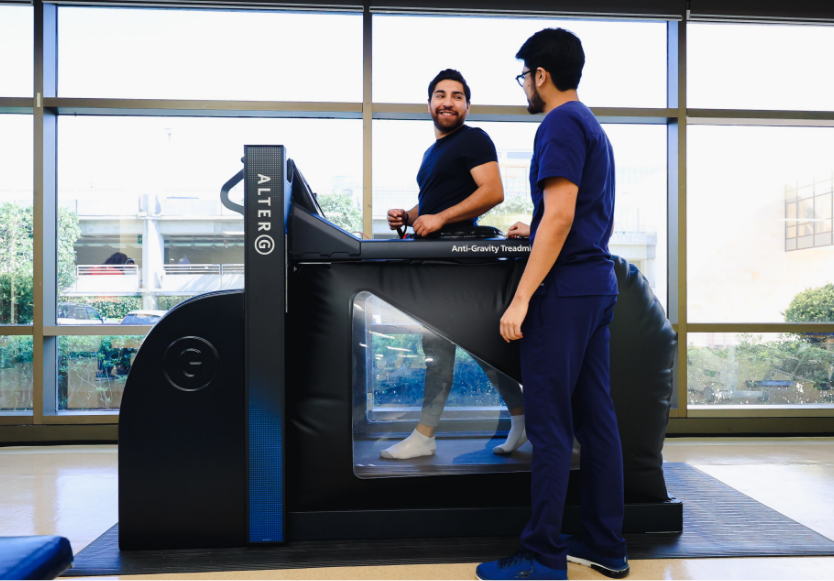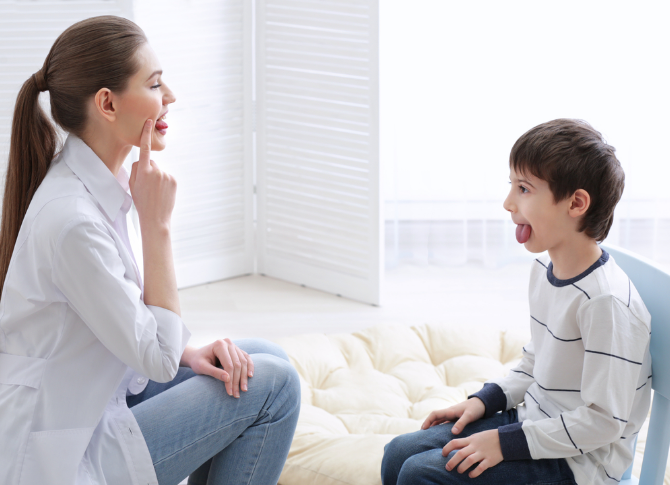Physical Medicine
and Rehabilitation.
ABC Medical Center Rehabilitation Medicine is dedicated to the recovery, restoration of health and reintegration into the environment of those patients with functional limitation or aftereffects that condition disability through comprehensive care programs where a diagnosis is made and the proper treatment.
The disciplines available at the rehabilitation service are:
Physical therapy:
Speech and swallowing therapy:
Occupational therapist:
Cognitive therapy
The American Speech-Language-Hearing Association (ASHA) classifies speech disorders as:
Articulation disorders.
Fluency disorders.
Resonance or voice disorders.
Oral dysphagia/eating disorders.
The American Speech-Language-Hearing Association (ASHA) classifies speech disorders as:
Articulation disorders.
Fluency disorders.
Resonance or voice disorders.
Oral dysphagia/eating disorders.
When is therapy necessary?
- Hearing problems.
- Cognitive (intellectual, reasoning) or other developmental delays.
- Weak oral muscles.
- Birth defects such as cleft lip and palate.
- Autism.
- Motor problems such as cerebral palsy.
- Breathing problems (breathing disorders)
- Swallowing disorders.
- Infectious, traumatic brain injuries.
- Stroke.
- Multiple sclerosis.
Diagnoses that are attended in Rehabilitation Medicine:
Neurological
- Stroke.
- Spinal cord injury.
- Head trauma.
- Brain damage of any kind (encephalitis, encephalopathy, hydrocephalus, anoxo ischemic encephalopathy, minimally conscious state, neurosurgical procedures such as craniotomies, etc.).
- Neurological disorders.
- Multiple major trauma: such as brain and spinal dysfunction.
- Parkinson’s disease.
- Movement disorders.
- Multiple sclerosis.
- Guillain Barre syndrome.
- Amyotrophic Lateral Sclerosis.
- Developmental delay.
- Myelomeningocele.
- Muscular dystrophies.
- Peripheral N lesions.
- Spinal muscular atrophies.
- Cerebral palsy.
- Imperfect osteogenesis.
Orthopedic
- Amputations.
- Polytraumatized.
- Hip and knee replacements.
- Congenital problems.
- Posture defects: Flatfoot, pes cavus, genu valgum, genu varum, scoliosis)
Others
- Burns.
- Systemic vasculitis.
- Heart disease (AMI, angina).
- Oncological diseases.
- Polyarticular diseases.
- Rheumatological diseases.
- Polyneuropathy of the critically ill patient.
- Weakness and deconditioning.
- Chronic lung disease.
Types of therapies that are provided
according to the type of care
PHYSICAL THERAPY
- Therapeutic tank.
- Whirlpool tub and Hubbard
- Electrotherapy
- Fluid therapy
- Cervical y lumbar traction.
- Mechanotherapy
- Equitest
- Magnetotherapy
OCCUPATIONAL THERAPY
- Labor rehabilitation
- Bioness
- Multisensory stimulation
- Functional adaptations
- Training in daily activities
- Wheelchair use training
- Passages
- Home adaptations
LANGUAGE THERAPY
- Articulation disorders
- Fluency disorders
- Resonance or voice disorders
- Augmentative communication
- Alternative communication
SWALLOW THERAPY
- Oromotor stimulation.
- Vital-stim.
COGNITIVE THERAPY
- Assessment and treatment.
PHYSICAL THERAPY
- Whirlpool tub and Hubbard
- Lymphatic drainage
- Electrotherapy
- Cervical y lumbar traction.
- Mechanotherapy
- Magnetotherapy
- Pressotherapy
OCCUPATIONAL THERAPY
- Labor rehabilitation
- Multisensory stimulation
- Functional adaptations
- Training in daily activities
- Wheelchair use training
- Passages
- Home adaptations
LANGUAGE THERAPY
- Articulation disorders
- Fluency disorders
- Resonance or voice disorders
- Augmentative communication
- Alternative communication
SWALLOW THERAPY
- Oromotor stimulation.
- Vital-stim.
COGNITIVE THERAPY
- Assessment and treatment.
Types of therapies that are provided according to the type of care:
PHYSICAL THERAPY
- Therapeutic tank.
- Whirlpool tub and Hubbard
- Electrotherapy
- Fluid therapy
- Cervical y lumbar traction.
- Mechanotherapy
- Equitest
- Magnetotherapy
OCCUPATIONAL THERAPY
- Labor rehabilitation
- Bioness
- Multisensory stimulation
- Functional adaptations
- Training in daily activities
- Wheelchair use training
- Passages
- Home adaptations
LANGUAGE THERAPY
- Articulation disorders
- Fluency disorders
- Resonance or voice disorders
- Augmentative communication
- Alternative communication
SWALLOW THERAPY
- Oromotor stimulation.
- Vital-stim.
COGNITIVE THERAPY
- Assessment and treatment.
PHYSICAL THERAPY
- Whirlpool tub and Hubbard
- Lymphatic drainage
- Electrotherapy
- Cervical y lumbar traction.
- Mechanotherapy
- Magnetotherapy
- Pressotherapy
OCCUPATIONAL THERAPY
- Labor rehabilitation
- Multisensory stimulation
- Functional adaptations
- Training in daily activities
- Wheelchair use training
- Passages
- Home adaptations
LANGUAGE THERAPY
- Articulation disorders
- Fluency disorders
- Resonance or voice disorders
- Augmentative communication
- Alternative communication
SWALLOW THERAPY
- Oromotor stimulation.
- Vital-stim.
COGNITIVE THERAPY
- Assessment and treatment.
Where to Find Us

Campus Observatorio
Sur 136 No. 116, Col. Las Américas, Álvaro Obregón, 01120, Cd. de México.

Campus Santa Fe
Av. Carlos Graef Fernández 154, Col. Santa Fe, Cuajimalpa, 05300, Cd. de México.










